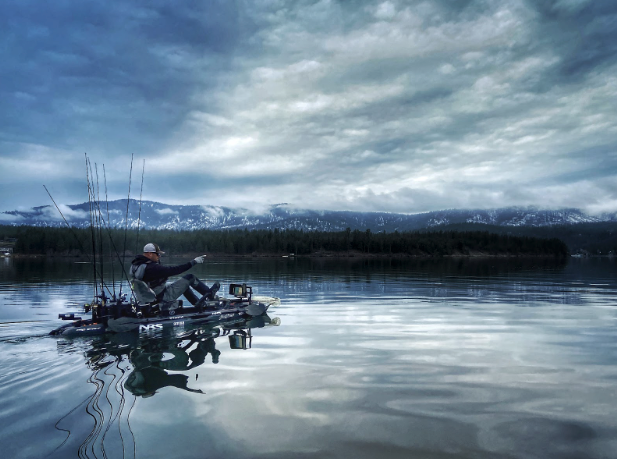When most people think of kayak fishing, sunny days, warm temperatures, and tank tops come to mind. Don’t get me wrong, I love a warm spring day when the topwater bite is on. But when push comes to shove, I have a new favorite time of year on the water.
Deep winter fishing is my new favorite.
I’m not just saying that to write a blog either. Of course, I love fishing in the spring. Who doesn’t? Summer is a blast and in my opinion the hardest season to fish. Fall is peaceful, and can be very productive. But in my opinion, nothing beats deep winter fishing in a kayak.
I don’t know where you live, but just a couple hours from Canada, along the Washington / Idaho border lies Spokane, Washington, a city with four seasons; one of them being winter. Not just put on a jacket, winter, but bone-chillingly, brutally cold, winter. The kind of cold that will make even the most hardened fisherman think twice about a trip. Just this week it was -35° with wind chill. That's cold. But in the heart of the winter good things are happening below the surface.
So if it’s so cold, why get the kayak out? Why endure the cold and harsh conditions? Because your PB is out there. I just caught mine last week, and you can too.

So here are my four best tips for catching bass in cold water.
Know your target
If you intend to catch fish in the dead of winter you need to know your fish and your local fisheries. If you are in the northern half of the country (where it gets really cold) your best option is to target smallmouth. They tend to relate to the bottom more than largemouth do, meaning, in general, you will find them near the bottom. Smallmouth are more active in the winter than largemouth, so they are easier to catch. So if you live in the north, look for large reservoirs that don’t freeze, most of those will have smallmouth. Your winter target is smallmouth.
If you are in the southern part of the country, look for lakes that have spotted bass. Spots also tend to relate to the bottom more than largemouth. While largemouth will, more often than not, be suspended, the spotted bass will be closer to the bottom. Look for lakes and reservoirs with spotted bass. If you live in the south, your winter target is spotted bass.
Change your depth
During the spring and summer, bass tend to spread out in lakes. They seem to be anywhere from 6” to 20’ deep. You might get fish on topwater, and you might get them on a deep diving crankbait.
In the winter, both up north and down south, when the water temps are in the 30’s and 40’s, the bass tend to congregate deeper. Instead of a 20’ band of depth to fish, you can key in on a band of only 15’-20’. We want to be looking for both smallmouth and spotted bass near the bottom in 20’-40’ of water. They won’t be near the surface. And they won’t be in 60’. They will be near the bottom in 20’-40’ of water.

Find your structure
In the winter the bass like to stay relatively close to structure to both preserve tiny amounts of heat and have something to relate to. You may be able to pick off wanderers, but the majority of the fish in your local cold water fishery will be at a depth of 20’-40’ and near structure.
My local winter fishing spot is a dammed-up highland reservoir. It has a sandy bottom and a 100’ deep creek channel in the middle. One side is a very rapid transition to that creek channel, and the other is more gradual. The gradual side is pretty barren, except for a 40-yard wide by 150-yard long boulder field that runs from 15’ deep to 60’ deep. That is my main target every time I go out in the heart of winter.
Change your lures
As fall gives way to winter around the country and the water temperatures drop, so does the metabolism of bass. They eat less, and they move less. Our presentations have to slow down as well.
When water temps are in the 50’s, a slower presentation like a jerkbait works really well. But as those same waters drop into the 40’s and 30’s, you have to go even slower.
While some fishermen will turn to a hair jig in these temps, my favorite lure in very cold water is the blade bait. I don’t understand the reasons why it works so well, and when I first bought one I thought I was wasting my money. But the thing just produces. My two favorites are the Damiki Vault, and the blade bait made by Norisada Custom Tackle.
To use these lures, just cast them and let them hit the bottom. Let your line go slack, and then just pop them off the bottom 6”-8” until you feel a tiny bit of vibration. Then let the lure pendulum back to the bottom slowly. Let it sit there for 3-5 seconds and then pop it again.

Winter fishing can not only be incredibly peaceful and tranquil but also very productive. In fact, on average I catch more and better quality bass per hour out of 36° water in January than out of 78° water in August.
Winter is such a great time for fishing. You generally have the lake to yourself; it is peaceful and quiet. It’s a great time to reflect. But it’s also a great time to catch some huge fish. So know your target, change your depth, find your structure, and change your lures. And if you do, it will open up a whole new season of productivity on the water.
Written and edited by Bobby Ulrich, Feelfree US Pro Staff

